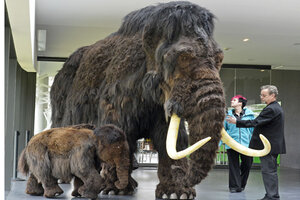Lions and humans likely collaborated in mammoth slaughter
A recently unearthed, strawberry-blond mammoth specimen from Siberia gives researchers new information about how humans and lions hunted.

People examine mammoth reproductions in the exhibition 'Giants of the Ice Age' in the foyer of the visitors center 'Ark Nebra' in Nebra, central Germany in March 2012. A recent mammoth find in Siberia provides evidence of human interaction with the woolly beasts.
AP Photo/Jens Meyer
After being frozen under Siberian ice for at least 10,000 years, well-preserved, recently discovered mammoth remains are providing clues about the past.
The details of how the massive mammal lived and died are still being interpreted by scientists. But it looks like hungry humans played a role in its demise.
"This is the first relatively complete mammoth carcass -- that is, a body with soft tissues preserved -- to show evidence of human association," Daniel Fisher, curator and director of the University of Michigan's Museum of Paleontology, told Discovery News.
From scratches in the mammoth's hide and bite marks in the tail it looks like the mammoth, known as Yuka, was chased by lions. Not long before death, Yuka also appears to have fallen, breaking a hind leg.
Humans apparently butchered the strawberry-blond beast, taking what they wanted. Clues to the role humans played in slaughtering Yuka include the absence of the skull, spine, ribs and pelvis. In addition, the shapes and patterns of the cuts indicate the use of human tools.
It's possible that people intentionally used the lions to wear down their prey and then drove the lions off to harvest the meat for themselves. Even now, a tribe in Kenya called the Dorobo steals prey from lions.
After taking what they could immediately use, suggests Fisher, the humans may have buried the animal with plans of returning later. "What remains now would then be 'leftovers' that were never retrieved," he suggested to the Discovery Channel.
This specimen will help researchers connect the physical features of Yuka with DNA information, according to Kevin Campbell, a University of Manitoba scientist who reconstructed mammoth hemoglobin in 2010.
In future mammoth findings, scientists will be able to infer physical characteristics like eye or hair color directly from genetic material, according to the BBC.
The expedition was part of a collaboration between the BBC and the Discovery Channel.

